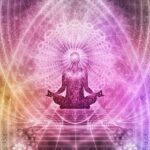Philosophical “Monism” is, in broad terms, the idea that all existence is, or is encompassed by, a single universal force, substance, or mode of Being. It’s a concept seldom used but often unconsciously assumed in everyday thinking about things like a universal God (a Being or force that encompasses all existence), a scientific “theory of everything”(that would unify all of nature’s foundational aspects and fundamental forces under one conceptual framework),universal ethical principles (like justice and goodness), or the concept of truth as it is usually understood (a ‘true’ objective fact or belief about reality is supposed to be the single correct way things really are—as opposed to innumerable subjective opinions about reality, or the countless ways things could be). The concept of monism is also important to the study of comparative cultures, as it remains fundamental (and common) to many classical or ancient religions, philosophies, and spiritual traditions across the world. It underwrites the way in which an all-encompassing divine Godhead in the Abrahamic religious traditions is conceived. It inspired Pre-Socratic concepts like “Being” in Parmenides’ philosophy, “The Unbounded” in Anaximander’s thought, and even “Heraclitan flux“, insofar insofar as it was understood as the single element inherent in all things. Similarly, monism was the basis for Plato’s ultimate unifying “Good”, and neo-Platonic ideas like the universal “One” of Plotinus. Even anti-Platonic notions like Nietzsche’s “will” and Henri Bergson’s “elan vital” (or all-encompassing life-force) are a monistic principles that unify and ground their respective worldviews – at least insofar as Nietzsche can be said to have had a worldview. In Chinese thought, “the Tao” of both Lao Tzu and Confucius is the single ground from which Yin/Yang, Qi, Li, and the Five Principles configuring Chinese cosmology all derive—similar to “Wu” (emptiness) or “Universal Mind” of Chinese Buddhism and “Tai Chi” or the “Supreme Ultimate” of neo-Confucianism. Many Indigenous religions also recognize a single, supreme, unifying principle encompassing all existence—from the native American Lakota people’s “Inyan” or primordial formless existence, manifesting the world via its creative power of “Wakan Tanka” , to the supreme Spirit of Mande religion in west Africa, generating existence through the spiritual force of “Nyame”. In south Asian traditions, Sikhism’s Akal Purakh and Hinduism’s Brahman serve as monistic principles unifying originative principle from which all existence and existents emanate.
Monism is also essential to south Asian Advaita Vedanta Hindu philosophy’s concept of Brahman (the all-encompassing “one without a second”, that encompasses and pervades everything). In his classic summation of Advaita Vedanta, Eliot Deutsch defines Brahman as “a name for that fullness of being which is the ‘content’ of non-dualistic spiritual experience: an experience in which all distinctions between subject and object are shattered and in which remains only a pure unqualified ‘oneness’. “ (1969:13) Monism is also characteristic of preeminant modern Advaita Vedanta philosopher Sarvepalli Radhakrishnan’s “neo-Vedanta” version of Advaita Vedanta, but is perhaps more malleable and loosely formulated than that of its originators, Sankara or Gaudapada. Radhakrishnan conceived of Brahman as an articulation of what he often referred to as “monistic idealism” in both Western and Eastern thought, and which has assumed a variety of forms in both traditions, although he believed it attains its most comprehensive expression in the “Advaitic monism” of Hinduism. This idea has prominent exponents in Western philosophy from Gnostic and pre-Socratic philosophy, to Christian mysticism, to German Idealism and existentialist theology.
In fact, Radhakrishnan notes significant similarities between pre-modern south Asian and European philosophical and religious thought that indicate the possibility of direct cross-cultural influence in this respect. Originating with the western Orphic and Gnostic sources that inspired them, monistic worldviews successively established the foundation for concepts like the “Good”, the “One”, and God in Christian theology which, like Hindu Brahman, represented a single, all-encompassing source of reality. “Whether or not we accept the hypothesis of direct influence from India on Greece through the medium of Persia”, Radhakrishnan states, “a student of Orphic or Pythagorean thought cannot fail to see that the similarities between these and Indian religion are so close as to warrant regarding them as expressions of the same way of life”. Several prominent neo-Platonist scholars have also explicitly argued for the direct influence of south Asian philosophy on neo-Platonic thought and, noting an Upanishadic verse affirming the basic unity of existence, “…the unity in all diversities….the self as the Universal soul” Vedanta scholar Bimal Krishna Mitalal claims that monism in “the thought of the Upanishads influenced not only Buddhism….but also the Neo-Platonics, Christian mystics, and even Persian Sufis.”
Moreover, an abundance of recent scholarship in the history of science and religion has explored how this persistent strain of monism in classical western philosophy (with its possible intellectual roots in south Asian traditions) also configured the historical foundations and purview of Western science. Mary Jane Rubenstien and Marcelo Gleiser illustrate how the implicit–and sometimes explicit– urge toward monism in contemporary theoretical physics, astrophysics, and cosmology, are the intellectual inheritance of classical sources as diverse as the ‘logos’ of ancient Greek Stoicism, the ‘Void’ of Hellenistic Atomism, God of Medieval Scholasticism (via Aristotle’s Prime Mover that inspired it), and the boundless universe of Neo-Platonic Renaissance cosmologists like Giordano Bruno and Nicholas of Cusa. Other interpreters of current physics like Paul Davies and Stephen Barr see contemporary cosmology’s grand vision of a “theory of everything” (so called by physicist Stephan Hawking and others) as the single, transcendent source of the modern laws of physics and the modern physical universe, which reflect the legacy of Platonic Forms and divine Law governing the classical/medieval universe. All of this illustrates the influence of ancient metaphysical monism on contemporary Western cosmology, which is in many ways similar to that of Advaita Vedanta, and which may be largely an inheritance of this tradition.
In contemporary philosophies of mind, theories like “analytic idealism’ and “cosmopsychism” attempt to reconcile the ever-intractable mind-body problem (popularly known as “the hard problem”) via a kind of monism by maintaining that the entire physical universe is comprised of consciousness in some form. In current scientific cosmology, monistic “block universe” theories –advocated in one form by Albert Einstein, among others– conceive of the physical universe as an ultimately undifferentiated primordial unity transcending but encompassing and configuring spacetime, and in theoretical physics “quantum monism” claims that, because of ‘quantum entanglement‘, binding every existing aspect of the universe since the initial cosmic singularity or “Big Bang”, the universe in totality inheres in a unified quantum state. This, according to its advocates, resolves or at least deflates problems associated with “multiverse theories” in quantum physics, string theory, and eternal inflation cosmology, which view reality as fundamentally separate and multifarious. “According to quantum monism”, writes physicist Heinrich Pas, “the fundamental layer of reality is not made of particles or strings but the universe itself—understood not as the sum of things making it up but rather as a single, entangled quantum state”.
Contemporary paradigms like these offer a general mode of rapprochement between post-modern science and ancient religious thought which, in the spirit of monism itself, may serve to unify all monistic global worldviews under a common banner. Western philosophy of mind and scientific physics-cosmology have re-configured the purview of western monism in a more expansive way that may now come, full circle, back to the spirit of Advaita and neo-Vedanta metaphysical monism which may in fact be their original source.



